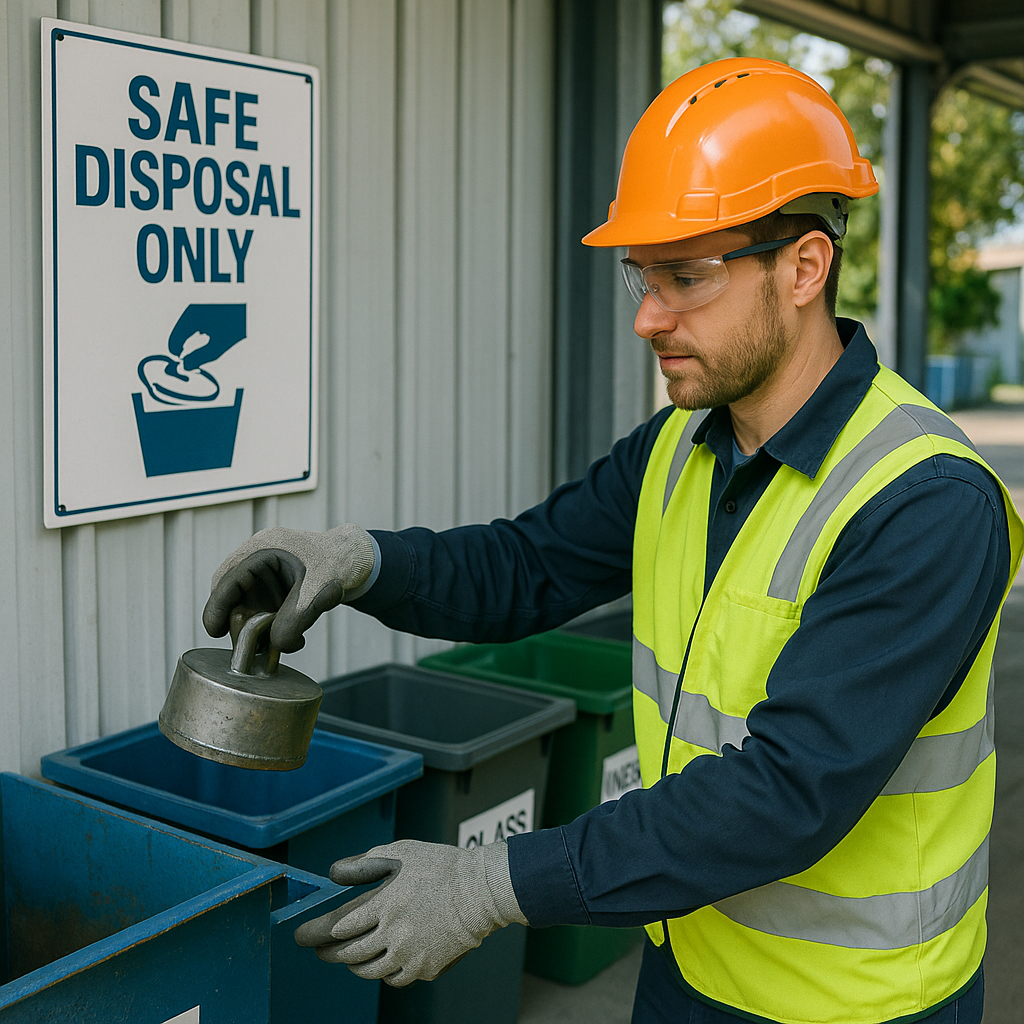5901 Botham Jean Blvd, Dallas, TX 75215
The Importance of Proper Industrial Magnet Disposal
July 22, 2025Industrial magnets are essential components in many manufacturing applications. These powerful tools separate metals, lift heavy objects, and drive critical processes in recycling facilities. However, proper disposal is crucial once these magnets reach the end of their useful life.
Improper disposal of industrial magnets poses significant risks. When discarded into regular waste streams, strong magnets can attract metal objects unexpectedly, damaging equipment and posing serious safety hazards to waste management workers. Magnets also contain valuable materials, including rare earth elements like neodymium and samarium, which can contaminate soil and water if not discarded properly.
The environmental stakes are particularly high with magnets containing rare earth metals. These elements can leach into ecosystems, disrupting habitats and potentially entering groundwater supplies. Beyond environmental concerns, businesses that improperly dispose of industrial magnets may face substantial fines and legal penalties for violating waste management regulations. Adopting responsible disposal practices protects the environment, recovers valuable resources, and ensures regulatory compliance.
What Are the Risks of Improper Industrial Magnet Disposal?

Improper disposal of industrial magnets poses significant risks to the environment and technology. When these powerful tools reach the end of their lifecycle, careful handling and specific disposal protocols are essential. Without proper disposal procedures, several serious hazards can emerge.
Demagnetization of Other Magnets
Strong industrial magnets can interfere with the magnetic properties of other magnets when improperly discarded. This occurs because powerful magnetic fields can realign the magnetic domains in nearby magnets, reducing or completely neutralizing their strength. For businesses relying on precision magnetic equipment, this can lead to equipment failure and production delays.
For example, when discarded neodymium magnets from manufacturing equipment were improperly stored near a facility’s quality control instruments, the testing equipment became demagnetized, leading to inaccurate measurements and costly production errors.
Electronic Interference Hazards
Magnetic materials carelessly disposed of can cause significant interference with electronic equipment. The magnetic fields can:
- Corrupt data on magnetic storage media like hard drives
- Disrupt the function of sensitive electronic components
- Interfere with medical devices such as pacemakers
- Cause malfunctions in navigation equipment
This interference can be particularly problematic in settings where electronic precision is crucial, such as hospitals, data centers, or navigation systems.
Physical Safety Hazards
The strong magnetic fields from improperly disposed industrial magnets can create immediate physical dangers in waste processing facilities. These include:
- Rapid attraction of metal objects that can cause pinching injuries
- Projectile hazards when ferrous materials are suddenly pulled toward magnets
- Crushing risks when large metal objects are unexpectedly attracted to strong magnets
- Injuries to waste handling personnel during sorting and processing
Waste management facilities have reported incidents where workers suffered injuries when magnetic materials in waste streams suddenly attracted metal tools or equipment components.
Environmental Contamination
The most long-lasting risk of improper magnet disposal is environmental contamination. Industrial magnets, particularly rare earth magnets, contain elements that can be harmful when they leach into soil and water systems.
Neodymium magnets, among the most powerful industrial magnets, contain rare earth elements that can contaminate soil and water when they break down. These elements, including neodymium and dysprosium, can persist in the environment for decades. The extraction process for these elements is environmentally intensive, making their proper recycling especially important.
In 2019, researchers discovered elevated levels of rare earth metals in groundwater near a landfill that had received industrial waste containing magnets. This contamination affected the local water supply and required expensive remediation efforts.
Regulatory Compliance Issues
Beyond the physical and environmental risks, improper disposal of industrial magnets can lead to regulatory violations. Many regions have specific regulations governing the disposal of magnetic materials, particularly those containing rare earth elements. Non-compliance can result in substantial fines and legal consequences for businesses.
Understanding these risks is essential for developing appropriate disposal strategies for industrial magnets. Proper disposal not only protects the environment and prevents equipment damage but also ensures compliance with increasingly stringent waste management regulations.
What Are the Legal Requirements for Industrial Magnet Disposal?

Industrial magnet disposal is governed by a complex framework of regulations at federal, state, and local levels, designed to prevent environmental contamination and ensure proper resource recovery. Understanding these requirements is essential for businesses handling magnetic materials.
The Federal Government mandates thermal demagnetization of rare earth magnets before disposal. This involves heating the magnets beyond their Curie temperature to eliminate their magnetic properties, making them safer to handle. For neodymium magnets, this typically occurs at temperatures above 175°F (80°C).
Many jurisdictions classify strong industrial magnets as hazardous materials, especially when they contain rare earth elements. The U.S. Department of Transportation regulates the transportation of magnetic materials under the Code of Federal Regulations (CFR) 49 parts 100-185. Any magnetic material with a field strength greater than 0.00525 gauss at 15 feet is considered a hazardous material for air transport purposes.
Recycling Requirements
Recycling, rather than conventional disposal, is increasingly required for industrial magnets due to environmental concerns and the strategic importance of rare earth elements. Magnets containing materials like neodymium, samarium, and cobalt need specialized processing facilities.
Facilities handling magnetic materials must comply with the Waste Electrical and Electronic Equipment (WEEE) directive or similar regional regulations. These frameworks set requirements for the collection, recycling, and recovery of electronic waste, including components with magnetic elements.
Companies must maintain accurate documentation of their magnet disposal processes, tracking the chain of custody from decommissioning through final processing. Failure to maintain proper records can result in significant penalties, even if the physical disposal was handled correctly.
State and Local Compliance
State regulations often impose stricter requirements than federal standards. California, for instance, has extensive regulations under its Department of Toxic Substances Control affecting magnet disposal. Local waste management authorities may have additional requirements or offer specific collection services for magnetic materials.
To ensure compliance with all applicable regulations, organizations should:
- Consult with local environmental agencies about specific requirements
- Partner with certified waste management companies experienced in handling magnetic materials
- Consider using steel containers to store magnets before disposal to prevent attraction to waste disposal equipment
- Explore specialized recycling services that can recover valuable rare earth elements
Many recycling facilities now offer services specifically for magnetic materials, recognizing the value of reclaiming these resources. The recycling process usually involves grinding the magnets, separating the materials, and refining them for reuse in new products.
Non-compliance with magnet disposal regulations can lead to substantial fines and potential liability for environmental damage. The cost of proper disposal should be factored into project planning when dealing with industrial magnets.
Conclusion: Ensuring Safe and Responsible Industrial Magnet Disposal

Proper disposal of industrial magnets requires careful planning and execution. These powerful tools contain valuable materials that can be recycled and harmful components that must be managed responsibly. Successful magnet disposal depends on following established protocols for demagnetization, separation, and recycling. When businesses prioritize proper disposal methods, they comply with regulations and contribute to resource conservation and environmental protection.
Environmental responsibility begins with recognizing that magnets, especially those containing rare earth elements, require special handling. By working with specialized recycling facilities and following thermal demagnetization requirements, companies can minimize their ecological footprint while potentially reclaiming valuable materials. Proper industrial magnet disposal is not just a good practice—it is often required by law. For expert guidance on recycling or disposing of your industrial magnets, contact Okon Recycling at 214-717-4083.
